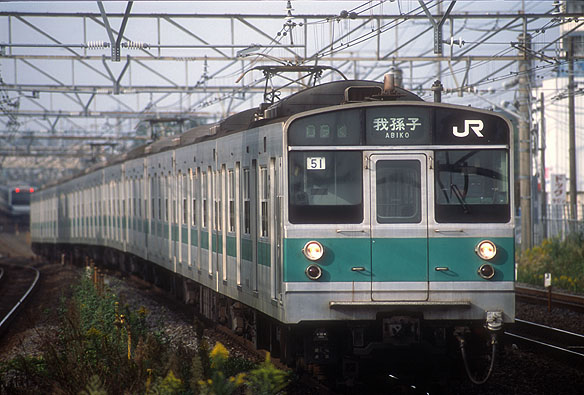Background and overview
103-1000 series EMU, employing armature-resistance control, used on Johban
Line and Tokyo Metro Chiyoda Line interrunning services caused temperature
rise of underground railway tunnel because of the waste heat from the traction
resistor while acceleration or rheostatic braking. In addition, Japanese
National Railways (JNR) were paying the difference of power consumption
between JNR 103-1000 series and Tokyo Metro 6000 series employing armature-chopper
traction control system and regenerative braking.
In 1982, since quadruple track of Joban line and interrunning service were extended to Toride, JNR developed 203-0 series commuter DC Electric Multiple Unit (EMU) train pre-production set for the additional capacity. 6 out of 10 cars are powered. The quantity of motored vehicles in a set is smaller than 103-1000 series including 8 motored cars out of 10.
Car body
They have 2800mm narrow body. Their body design incorporates aluminum alloy
extrusion material in order to realize lightweight body. Their bodies are
5t lighter than 201 series. Their skin of the bodies is not finished under
no coating. They have the single emerald green waistline band running the
length of each car below the windows. They are equipped with 4 double-leaf
automatic sliding doors and pairs of double-hung unit assembled windows
on each side of the vehicles. Door case windows between the doors are omiited
for light weight. Door operating equipments, TK4, are fitted under the
seatings. Roller-binding destination screens are fitted on the body. End
cars are equipped with an emergency door in front of them. An air conditioner,
AU75G rated at 42,000kcal/h, is fitted on the centre of their roof. Forced
ventilators are fitted on the both side of the air conditioner.
Bogies
Their bogies are DT46A/TR234 adopting air suspension bogies and cylindrical
guide journal box supporting system. The thickness of the bogie frame is
3mm thicker than DT46/TR231 adapted to 201 series. Motored bogies employ
single tread brake device and trailer bogies employ double tread brake
device for light weight.
Traction unit and ancillary equipments
Eight powerful series-wound brushed DC traction motors, MT60, with a power
output of 150kW and featuring higher rated speed, are controlled by the
armature-chopper traction control system, CH1A, featuring reverse conducting
thyristor and traction system CS53A. The gear ratio is 6.07 for using Tokyo
Metro Chiyoda Line. 201 series adopt electromagnetic straight air brake
with regenerative brake. Regenerative brake is changed into full magnetic
field brake. The brake resistance is increased for the improvement of regenerative
brake availability at high speed. Class Moha203 vehicles are equipped with
a diamond-shaped current collector, PS21. Class Moha202 vehicles are equipped
with a motor generator, DM106, with a power output of 190kVA featuring
brush less, for the auxiliary power supply.
Accommodation
Seating is longitudinal throughout. Windshield plates are fitted at the
both end of seating. An AC duct is installed above the ceiling and slit-shaped
AC vents are featured in order to improve interior design.
Operations of pre-production set
The pre-production unit of 203-0 series entered the revenue services on
the Joban line and Tokyo Metro Chiyoda line in Nov., 1982.
Mass-Production sets
The first full-production standard set was delivered in 1984. There are some noticeable differences over pre-production set. Their regenerative brake can switch between full magnetic field brake and weak magnetic field brake for the improvement of regenerative brake availability at high speed.
Operations and withdrawal
Although 203-0 series had been used on the interrunning services of Johban
Line and Tokyo Metro Chiyoda Line, all vehicles were withdrawn by the displacement
to E233-2000 series in 2011. |
|

